Archived Commercial Blog Posts
Exploring the Fire Restoration Process for Your Business
7/25/2022 (Permalink)
Business owners like yourself need to be prepared for disasters, especially as part of an overall plan for workplace safety. Commercial fires not only pose a safety threat to your workers but they can also put your business at risk, especially if there’s a long interruption to your business. It’s critical to have a plan for recovery after a fire for your commercial property in Clearfield, UT. Knowing the steps to take ahead of time is critical, and can help you bounce back sooner from a fire-related disaster.
Creating a Fire Restoration Plan
After a fire has been completely extinguished, your recovery process should include the following actions:
- Documentation: Take several photos of the damage to your building and the objects inside. Make a note of anyone that you talk to, including officials, property managers or landlords. It’s critical to capture things as they are with photos and video. Do not touch impacted objects, and hold on to any invoices or receipts for expenses.
- Claims: Call your fire insurance company or representative as soon as possible. It takes time to process your claim, which can delay any payments you may need to make repairs or keep your business going.
- Professional Restoration: Notify a professional fire restoration or remediation services company. This company is experienced and equipped to find the most expedited and efficient way to restore your building to pre-damage conditions.
- Contingencies: Execute any contingency plans, which often include notifying clients, workers, subconsultants and other interested parties about the fire. Your plans should include special arrangements and changes to contractual agreements, where applicable.
- Security: Depending on the size of the fire and its impact, you may need to secure parts of your business to prevent damage and other types of loss, such as theft or vandalism.
- Offsite Removal: Any unaffected items should be removed so that they’re not damaged or destroyed during restoration or reconstruction.
Cleaning Up Your Space
When it comes to a fire, there may be other types of damage to consider. Smoke and soot can leave your interiors and items heavily soiled and damaged, requiring special cleaning techniques that only a professional fire remediation provider can handle. Any water used to extinguish the fire, whether by sprinklers or a fire hose, can also cause damage that requires cleanup and repair. From smoke cleaning to advanced drying techniques, you’ll be glad to have professionals on board to clean and restore your building.
Considering Insurance
In most cases, fire restoration costs can be covered by a fire insurance policy. Before a disaster occurs, it’s a good time to check to see if your coverage levels are sufficient. You may need additional coverages based on your operational needs. For example, umbrella policies often extend your coverage limits in the event of a catastrophic loss. The recovery period may be significantly longer than you planned, so business interruption or income interruption policies may help you with ongoing expenses, temporary costs, or other bills needed to keep your business open.
Understanding the fire restoration process helps you come up with a realistic recovery plan. Having such a plan can help expedite the time it takes to get back to business after a commercial fire in Clearfield, UT. It’s easier to dot all the I’s and cross all the t’s before disaster strikes.
How Commercial Owners Can Minimize Sprinkler Flooding
7/25/2022 (Permalink)
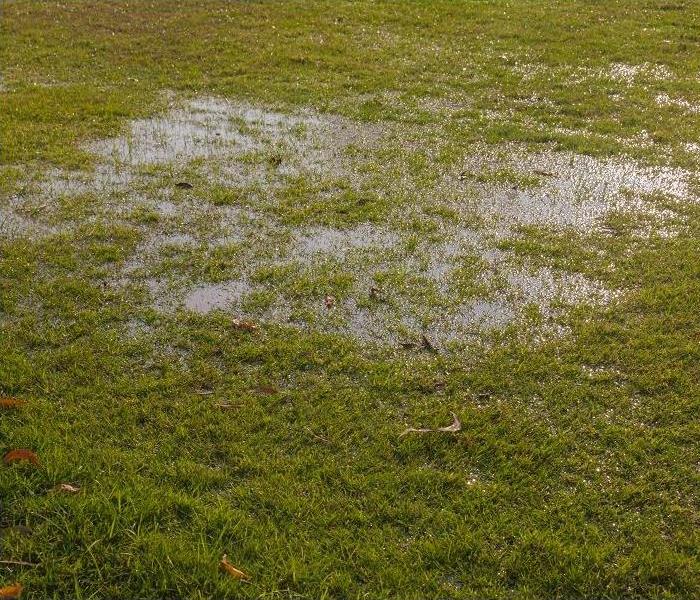 A broken sprinkler can cause flooding
A broken sprinkler can cause flooding
Keeping your commercial property in Clearfield, UT, lush and green is ideal, reflecting a pristine and attractive setting. However, that's not the only reason to focus on sprinklers. Proper irrigation maintenance minimizes several concerns, decreasing the company's utility costs and flooding probability.
Stopping Floods: The Importance of Irrigation Maintenance for Commercial Properties
According to the Environmental Protection Agency, EPA, a small leak has a significant impact. Even something the size of a dime could allow as many as 6,300 water gallons per month to go to waste. This loss adds to the water bill and begs the question: where does all that water go? It could seep into the soil, or it could flood the building. Adopt the following habits to catch issues and avoid water damage quickly.
1. Evaluate the System Regularly
You can program irrigation systems to go on at your will, setting automatic timers; this option offers you flexibility but limits your oversight. You won't know if something breaks or leaks. Therefore, set aside time to inspect the sprinklers before kicking them on.
The unit has multiple pieces, and they're vulnerable to issues. People can easily affect a sprinkler head placement by stepping on it or running equipment over it. Simple, everyday actions move spray direction or prevent operations. Thus, check each of the following pieces to see if they function correctly:
- Lines
- Heads
- Controller
- Nozzles
- Valves
If anything is slightly off, your land may not get what it needs. In addition, water could accumulate quickly, building up a flood. Move pieces into proper places and replace anything not working.
2. Look for Signs of Trouble
The potential for sprinkler flooding increases when you have something awry, and sometimes the land tells you more than the sprinklers themselves. Therefore, observe the grounds for changes or unusual appearances such as dryness, dips or puddles.
Pay close attention to the heads and nozzles. Is the water flowing evenly, or is it building around the piece? Intense sprays and low pressure indicate potential leaks or breaks.
If you cannot see a physical sign of distress but think something is off, contact a water remediation team for help. These professionals can use cameras to inspect the lines, determining where a breach has occurred.
3. Know How To Handle Floods Quickly
When a flood does occur, it's imperative to react quickly and appropriately. As part of your irrigation maintenance plan, prepare protocols for handling instructions. After all, water harms the building's structure, dampening materials and encouraging mold and mildew. What may seem harmless could create significant devastation. Have the phone number for water restoration specialists in Clearfield, UT, and call them as soon as you observe puddling or damage.
4. Get an Annual Inspection
Have experts review your irrigation system at least once a year, especially in the spring. Many companies turn off the designs in the winter. A lot of things can happen during those cold months. Professionals can assess the parts, fix anything amiss and get you on the right track for the warmer days.
Broken sprinklers increase the chance of a flood.
Protect your commercial property by prioritizing irrigation maintenance and checking your sprinklers before turning them on.
How SERVPRO's Claims Inventory System Helps Insurance Agents and Their Clients
5/23/2022 (Permalink)
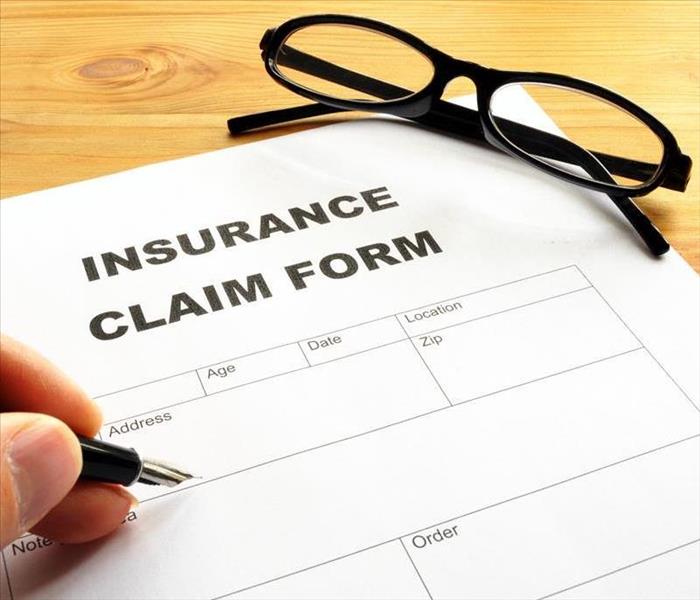 Learn More about our Claims Inventory System. For more information, just contact us.
Learn More about our Claims Inventory System. For more information, just contact us.
As an insurance agent in Clearfield, UT, you often deal with customers who are stressed. They may fear that some of their valuable documents have been destroyed by a flood or fire. They may also wonder if they will be able to re-open their businesses.
Filing an insurance claim can be a great hassle, as well. It is your job to alleviate this stress. You can do that by choosing a vendor such as SERVPRO that has a claims inventory system. This system allows you to easily track various claims.
Benefits of the SERVPRO Claims Inventory Service
1. Information Access
When processing a client’s claim, you will need quick access to relevant information, such as the costs of certain items. The claims inventory system allows you and your client to find important documents promptly. This will make it easier for you and your client to work together during the restoration.
2. Organization
Your client will have to provide a lot of paperwork when he files his claim. There will be numerous receipts and photographs that can easily get lost. The claims inventory service keeps all these documents in one place for better organization.
3. Expedited Process
The longer you take to process the insurance claim, the more frustrated your client will be. The property may also suffer additional damage during the delay, which will make the restoration last longer and the claim more expensive. However, if all the important information is accessible and organized, you will be able to finalize the claim more quickly. This should lead to more satisfied customers.
Other Benefits
It is not just the claims inventory system that sets this company apart from the rest. The company also has a separate National Accounts Division that manages relationships with insurance providers. This ensures that the cleanup experts and the insurers are all on the same page. There should be communication and transparency throughout the restoration process.
You and your clients can also trust that the remediation will be done promptly and according to Institute of Inspection Cleaning and Restoration Certification standards. This reduces each claim’s costs and makes your customers happier.
The company additionally uses internal audits to check for quality. It also hires workers who are trustworthy. Even temporary employees are subjected to background checks.
Employees are given the opportunity for continued training, as well. In fact, the business opened its own training facility in 1992. The company offers training for new franchisees and an employee certification program. The company is also an approved training school for the IICRC that provides classes on a variety of topics, including applied structural drying. There are even continuing education courses for real estate and insurance professionals. These classes cover emergency mitigation procedures.
When a client files an insurance claim, it should be easy for you to access the information about the property. Your client, meanwhile, will want the claim to be processed as quickly as possible. A claims inventory system can expedite the claim and keep all the required documents organized. When choosing an emergency restoration vendor, you should thus look for one that offers this service.
5 Key Components of a Fire Escape Plan
5/12/2022 (Permalink)
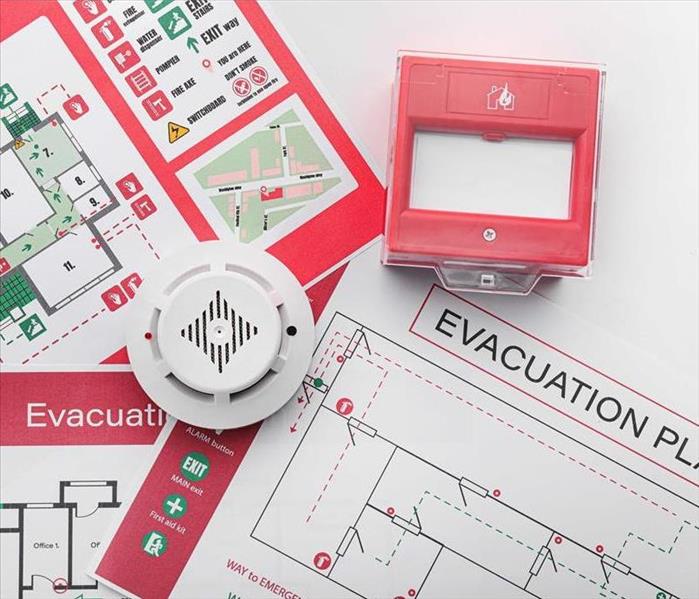 Develop a Good Fire Escape Plan by Following our Tips.
Develop a Good Fire Escape Plan by Following our Tips.
Knowing that there are an estimated 100,000 commercial property fires a year, it’s vital that businesses in Clearfield, UT, plan for the unexpected. While a commercial fire restoration company will be able to take care of the property, business owners need a well-thought-out fire escape plan to ensure everyone on the property is safe. When developing a plan, below are five steps to take.
Key Components of a Fire Escape Plan
1. Identify Potential Hazards
The first step is determining the potential risks to your business. Is there a kitchen? Are portable space heaters used? Are extension cords over their limit? Take a tour of the facility and look for areas that may create added risk. Once those are discovered, come up with a solution for each and communicate any cooking or heating rules to everyone onsite.
2. Map Escape Routes
A fire escape plan is essential to a successful evacuation. A map should be created of the facility, including primary and alternate escape routes. When creating the map, ensure you take into consideration any employees who may have special needs. Once the best route is determined, ensure that the path is always clear of any obstacles, such as furniture. The mapped plan should be posted throughout the facility to ensure that it is easy to see if a fire does break out.
3. Assign Roles
Dealing with a fire is a chaotic situation. Even if people know where to go, there may easily be confusion and added stress. As part of the evacuation plan, specific roles should be assigned to specific individuals to assist in an emergency situation. This may include a chief fire warden, who holds responsibility for the overall event and planning, as well as an assistant to help alert employees.
For larger businesses, consider assigning people as route guides to assist people as they exit via the designated escape route and others as point personnel for using the fire extinguishers.
4. Develop a Communication Plan
While the first thoughts may be on the fire itself, it has the potential to affect other people. Staying in communication with clients and employees’ relatives is essential. Prepare a list of essential contacts, including local hospitals, clients, suppliers and employee contacts. This list should be easily accessible to the fire warden or assistant to help deal with the aftermath of the fire.
5. Practice the Emergency Escape Plan
Even if you have the best plan of action, you still need to ensure it works by having regular drills. Along with reinforcing confidence in your designated fire team, it provides everyone onsite with added peace of mind that they have practiced evacuating the building and will be ready for the real situation. After each drill, the team is more easily able to address potential issues that may arise or make changes to the overall plan for added safety measures. These drills also reinforce how important employees are to the business.
No matter how small a business is, it should always have a fire escape plan. Ensuring that everyone knows what to do and where to go increases the chances of a safe evacuation.
7 Reasons To Use Security Fencing After a Fire
4/13/2022 (Permalink)
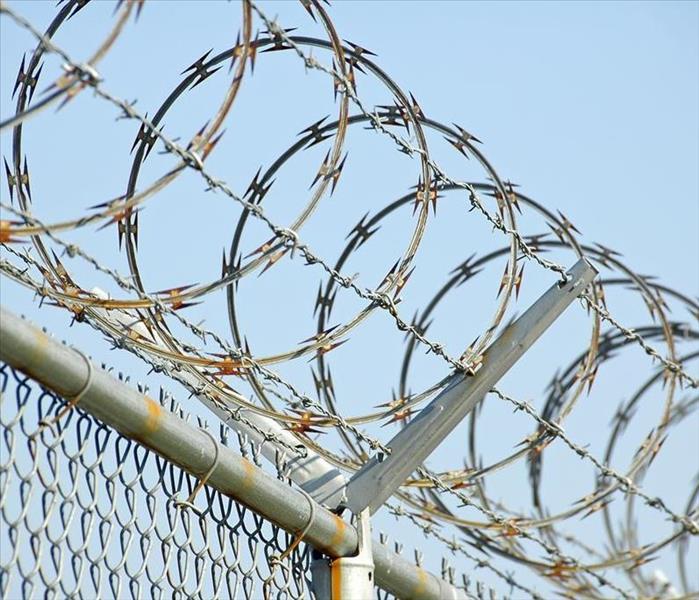 Security Fences can be really useful To Avoid Damage in your Property.
Security Fences can be really useful To Avoid Damage in your Property.
Many businesses use a security fence to protect employees and property from intruders. A fire-damaged building may be a particularly attractive target to thieves or vandals because some of the normal defenses may be gone and the building may be unoccupied. There are multiple benefits to using a fence to protect your fire-damaged building.
Benefits of Damage Security for Fire-Damaged Buildings
Unfortunately, looting can often be a problem in the wake of a fire. It is important to take steps to protect your property from looters, thieves and vandals.
1. Deters Crime
Most thieves and vandals prefer an easy target. A building that is surrounded by a strong, difficult-to-climb fence does not look like an easy target.
2. Is Customizable
Different types of businesses require different types of fences. You can choose from chain link, palisade or wire mesh. Chain link is attached to sturdy posts and is difficult to cut. You have the option of adding barbed wire to the top to make it more difficult to climb. Palisade fencing is made from rigid, steel posts with pointed tips at the top. This type of fencing is very sturdy and difficult to climb and may be more attractive than chain link. However, it is usually more expensive. Garrison fencing is constructed from welded tubular panels.
It is more attractive than chain link, but not as strong as palisade. Wire mesh is less expensive and easier to install than chain link, but more easily cut. It may be a good option for temporary fencing because of its lower cost.
3. Controls Access
Putting up a security fence makes it easier to control who is coming on your property. This can be particularly useful while cleanup and repairs are ongoing. You may have a variety of people, such as a fire remediation company crew, on your property who normally wouldn't be there. A fence helps you make sure criminals don't slip in undetected amongst the cleanup and repair workers.
4. Saves Money
There are other ways to protect your property, such as installing security cameras, alarms and entry control systems. However, these methods can be expensive. Fences are a relatively low-cost way to protect your property.
5. Is Easy To Maintain
Professionally installed fencing does not need regular maintenance and should last for years. Other types of security technology must be updated regularly and replaced as it becomes obsolete.
6. Provides Proactive Protection
Many types of security equipment, such as alarms, work by alerting you when an intruder is already on your property. A fence can keep an intruder from getting on your property in the first place.
7. Improves Your Security Permanently
A high-quality fence can last you many years. Having a professional installer in Clearfield, UT, put up a fence on your property not only provides protection while you are repairing your building but improves your security once the building is restored.
Adding a security fence to your fire-damaged property provides many benefits. It helps keep looters, thieves and vandals away from your building during the repair process and can be a permanent improvement to your building security.
Keep Business, Employees Before and After a Severe Storm
3/9/2022 (Permalink)
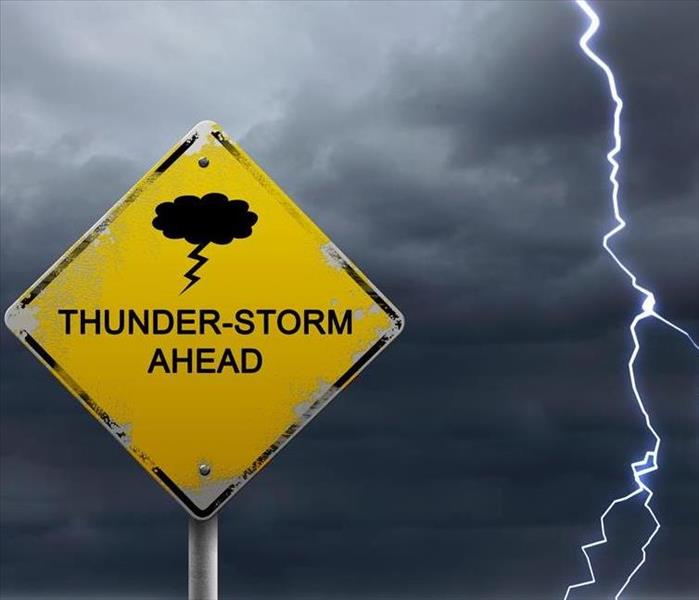 Be ready for Severe Storms by Following These Tips. If you have more questions, just contact us.
Be ready for Severe Storms by Following These Tips. If you have more questions, just contact us.
Severe weather may happen anytime in Clearfield, UT. For businesses, protecting assets and employees means being prepared prior to the rain storm arriving. Once the bad weather hits, it's vital to follow recommended safety precautions to minimize risk.
Building Maintenance Before a Storm
From high winds to lightning strikes, a building takes a beating during harsh weather. While it may be easy to forget when the weather is nice, regular maintenance and repairs are vital to the structure withstanding Mother Nature’s wrath. Below are a few tips to help reinforce your property.
Roof Maintenance:
Regular inspections are needed regardless of what type of roof your building has. Even less severe weather may begin to cause damage that will quickly become much worse during a severe rain storm. If any leaks or visible damage is detected, get it repaired immediately to avoid the need for costly repairs.
Secure Windows and Doors:
One broken seal may mean excessive water getting into places it shouldn’t. Regularly inspect seals, caulking, hinges and other hardware to ensure that the building is secure. Any signs of warping or rusting are indicators that these features may be compromised.
Landscaping:
If your property has any trees, ensure they are trimmed to avoid a branch falling on the roof or bursting into a window. Regularly check that gutters are free of debris and properly draining. Along with adding an aesthetic, planting bushes and plants may help absorb some of the excess water from a storm.
Lightning Protection System:
If a bolt of lightning hits your structure, or even nearby, it may produce a surge of power that may turn into a power outage or cause a fire. Strong winds may also cut the power. A protection system is designed to help handle those surges, helping to keep business running as usual and preventing a fire from breaking out.
HVAC Protection:
Hail is a common product of a storm, which means your HVAC system may get damaged. There are hail mesh, shields and guards that can be installed to prevent that from happening. These added layers should also be regularly checked. Also, ensure that whichever you choose is properly installed to resist wind.
Follow Safety Guidelines During a Thunderstorm
As secure as the structure may be, severe weather still requires making the safety of everyone around a priority. To help protect employees and anyone else on-site, staying inside is essential. It is recommended that people stay indoors for a minimum of 30 minutes after thunder is heard.
Additional safety tips include:
- Ensure windows and doors are tightly shut.
- Do not use ungrounded electrical equipment, including televisions and radios that are not battery powered.
- Try staying in an area away from windows.
- Since lightning is able to travel through pipes, stay away from water.
- Minimize contact with concrete, which is reinforced with metal bars or wires.
A rain storm comes with much more than excessive moisture, all of which can cause damage to a building. By taking steps to ensure your building is secure, it makes weathering the bad weather easier and safer.
What To Expect During a Pipe Burst Cleanup Procedure
3/7/2022 (Permalink)
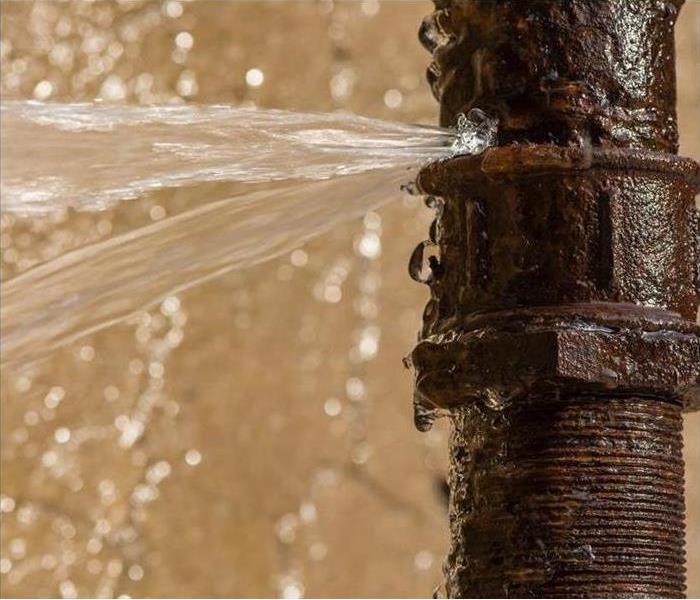 Learn more about what to expect during a Pipe Burst Cleanup by following these Tips.
Learn more about what to expect during a Pipe Burst Cleanup by following these Tips.
A leaking supply line or broken pipe can cause massive damage in a short amount of time. If you have never seen it before, you may wonder what happens during a pipe burst cleanup and repair.
Repair Pipe
The first thing any water mitigation company in Clearfield, UT, should do is repair any broken pipes or supply lines. No matter what, stopping the water is one of the most important things that they do. If you still have a pipe or supply line leaking, the damage will continue to grow. Make sure they repair the actual problem before they do any cleaning or rebuilding.
Extract Water
When your pipes are leaking, you can bet that there is water to be extracted. Even if you can't see it, there could be water behind or in your drywall, flooring or crawlspace. When the water gets into your carpet, it can start to smell bad. No one wants a musty-smelling business. Water extraction is a big part of any pipe burst cleanup.
Remove Damaged Items
Depending on what is damaged, sometimes a cleanup company will do this before they extract the water. They take out and dispose of all of the items that cannot be cleaned. The cleanup company should know the disposal rules for your area.
Dry the Area
They will then dry the area with chemicals or with fans. This process is time-consuming and should be done carefully. Leaving an area damp will cause more damage like mold and mildew. Developing mold or mildew can cause bad odors, among other things. A good water cleanup company will dry the affected areas thoroughly.
Sanitize and Deodorize
After the area is dry, it is time to sanitize everything and deodorize it. Your cleanup company will make sure that everything is prepped and ready for the repairs to begin.
When you are dealing with a pipe burst cleanup, it is helpful to know what will happen during the process. This helps you plan your business activities around the cleanup and repair process.
What Is Secondary Damage?
2/18/2022 (Permalink)
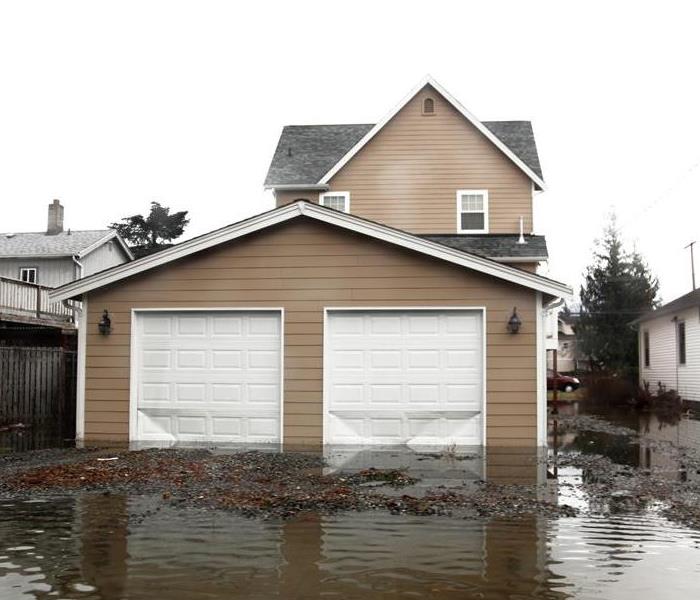 Learn more about Secondary Damage by following these tips.
Learn more about Secondary Damage by following these tips.
When you have water in your building due to a flood or leak, the water may directly damage your property. However, this is not the only risk that water poses. Water damage can also lead to secondary damage from black mold and other sources. Cleaning up water damage and fixing the source of the water problem is the key to preventing this additional damage.
What Are Some Common Types of Secondary Damage?
Water can cause problems not only due to the effects of the water itself but because of the high humidity caused by the water evaporating into the air in your building. There are several common problems typically caused by water damage:
1. Electrical Damage
Water that gets into the electrical sockets can severely damage the electrical system in your building. This may create a shock hazard. It may also increase the risk of an electrical fire. If there is a chance that water has gotten into your electrical system, shut off the power at the main breaker, or contact your utility company, and schedule an electrician in Clearfield, UT, to inspect and repair your system.
2. Wood Rot
Contact with water and humidity can cause structures made from wood to rot. Without repairs, this can create structural issues in your building.
3. Mold Growth
Black mold can begin to grow as soon as 24 hours after water damage occurs. This makes it important to resolve water issues as quickly as possible. If you are dealing with a flooded building, contact a water remediation company to remove the water and dry out your building. If you notice signs of mold, you may need to contact a mold remediation company to remove it.
4. Corrosion
Metal materials that have been exposed to water may rust. This can weaken the structure of the metal which can lead to additional damage, such as leaking pipes. Metal materials with signs of corrosion should be repaired or replaced.
5. Flooring Damage
Flooring materials, such as laminate or hardwood, may buckle when exposed to water. Buckled flooring must be removed and replaced. Promptly removing water from flooring materials may prevent buckling from happening. Drying the area under flooring is also important because water that is trapped under flooring materials can promote mold growth.
Other Causes of Secondary Damage
Many causes of property damage can also lead to additional indirect damage. For example, fire creates smoke and corrosive substances that can damage both your building and its contents. In some cases, the smoke damage is worse than the damage from the flames. Additionally, the water and chemicals used to put out fires can cause damage to your property.
Wind may cause indirect damage to your property by creating holes in your structure that allow rain or snow to penetrate your building leading to water damage. A lightning strike could indirectly damage your property by causing a power surge or a fire.
Black mold and other types of indirect damage can be serious problems. The best way to prevent this type of damage is to reduce the chance of the primary damage from occurring and remediate it promptly when it happens.
6 Tips for Dealing With a Water Damaged Wood Floor
1/14/2022 (Permalink)
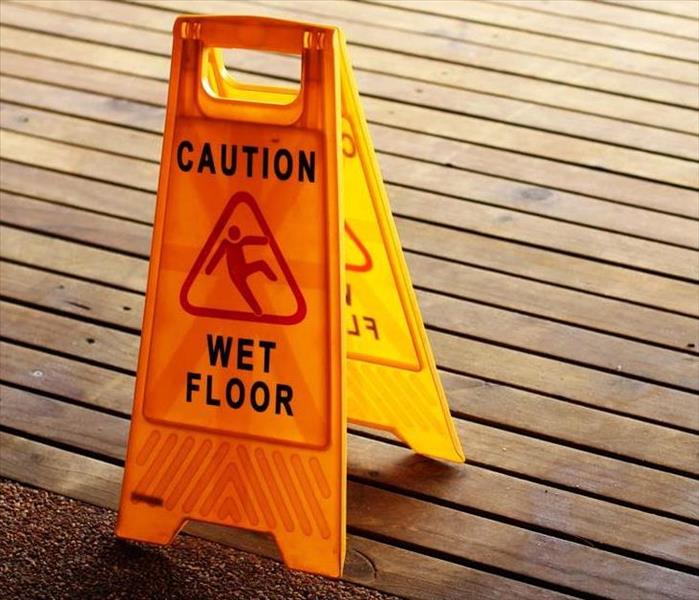 Bear in mind these 6 tips for dealing with a water damaged Wood Floor in Clearfield, UT.
Bear in mind these 6 tips for dealing with a water damaged Wood Floor in Clearfield, UT.
Getting any kind of flooring wet is not ideal, but water damage from a pipe burst or other source can be particularly damaging to wood floors due to the porous nature of the material. These tips can help you minimize the damage to your wood flooring.
How To Save Your Wood Floor From Water Damage
Drying your wet floor quickly is the most important thing you can do to reduce the amount of damage. These are some steps you can take:
1. Remove Wet Objects From the Floor
Wet objects, such as rugs and furniture, can continue to leech moisture into the floor. They may also develop mold and mildew that can infiltrate the seams and pores of your flooring. Remove all wet items and place them in an area, such as outside, where they can dry without damaging the floor.
2. Clean Up As Much Water as Possible
If you are dealing with a small spill, you can absorb the water with mops, towels and clean rags. For larger spills, such as a pipe burst, use a wet vacuum and run it until you no longer see any new water being pulled into the canister. If you don't have a wet vacuum, you may be able to rent one in Clearfield, UT.
3. Clean the Surface of the Wood
Debris and dirt in the pores of the floor can retain water and bacteria that may damage your floors. Clean the floor with a disinfecting cleaner that does not make suds. Use a soft-bristled scrub brush. After you have cleaned the floor, run the wet vacuum another time to remove any water and then use a wood floor cleaner to remove any leftover disinfectant. Rinse the floor and dry it one more time.
4. Thoroughly Dry the Wood
Even if your floor appears to be completely dry, there may be water that has penetrated the plank that can not be removed with a wet vacuum. Put a dehumidifier in the middle of the room and run it for at least 24 hours to help dry the floor. Position fans around the room to blow air across the surface of the floor. If the damaged floor is on an upper level, place fans on the level below and aim them at the ceiling to help dry out the subfloor. If the weather is dry, you can open doors and windows to increase air circulation.
5. Check for Mold
Mold can begin to develop 24 to 48 hours after water damage. Inspect the floor for signs of mold growth. If you believe you have a mold problem, consider contacting a mold remediation company to address the mold issue before it gets worse.
6. Test for Moisture
Use a moisture testing meter to check for any moisture remaining in the wood. It may take several weeks for your floor to completely dry out. Continue to run your dehumidifier and fans until no moisture remains.
The longer you wait to dry out your flooring after a pipe burst or other water damage occurs, the more damage your floor is likely to sustain. Taking quick action can prevent unnecessary damage.
The 4 Stages of Keeping Your Business Running After a Flood
12/19/2021 (Permalink)
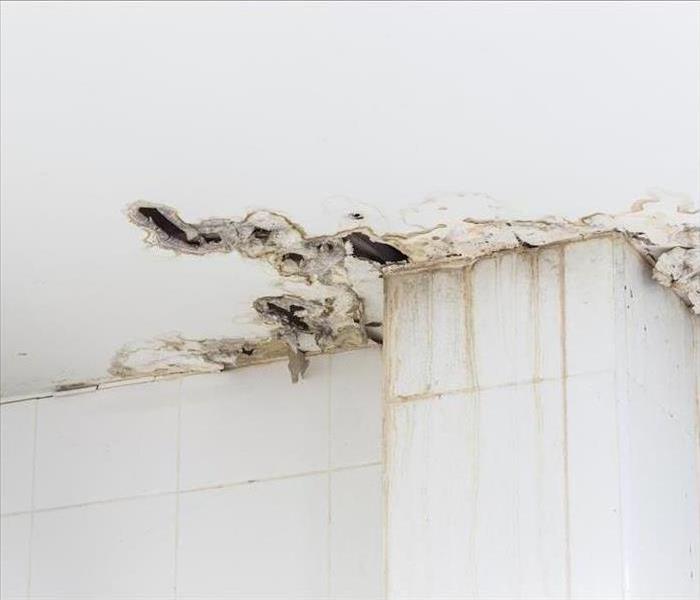 The ceiling of a building damaged with water after heavy rains.
The ceiling of a building damaged with water after heavy rains.
After a storm hits Clearfield, UT, your business may be flooded. Repairs with even the most efficient water damage specialists can take some time, and your business needs to keep running while they are in progress. Having a business continuity plan is essential to keeping your business going and your income flowing. Here are the four stages of constructing a plan that will help you weather storm damage to your building.
4 Stages of a Plan to Keep Your Business Running After Storm Damage
- Analysis
The first thing you must do is identify essential services and what you need to make them happen. Develop and distribute business impact analysis questionnaires to all personnel. Then conduct follow-up interviews to make sure your information is correct and that nothing is missing.
- Strategies
It is likely that your BIA will reveal discrepancies between what you would need in a flooding situation and what you are currently capable of doing should your business flood tomorrow. A recovery strategy team should be formed to come up with and implement strategies to eliminate those discrepancies.
- Plan
The third stage is formulating your business continuity plan. Divide the labor among recovery teams. Make decisions regarding relocation. Confirm that you have an information and document recovery system in place so that essential resources are protected. With management approval, write down the details of the plan.
- Practice
A plan is only as good as its execution, so it's important to test your plan. Train everyone involved, and give it a practice run. Take careful notes to document what works and what doesn't so that you can fix problems before you have to put the plan into action for real.
Once you have gathered information, omitted shortcomings, drafted a business continuity plan, and tested the plan, you can rest assured that stormy weather is unlikely to be your company's undoing. By being prepared for potential problems, you protect yourself and your employees.
4 Basic Steps To Protect Buildings From Storm Damage
6/22/2021 (Permalink)
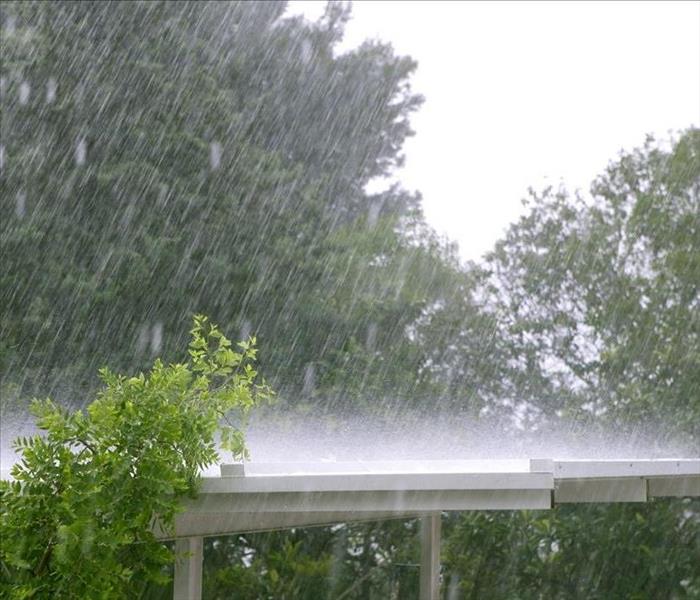 Heavy storms can damage your roof.
Heavy storms can damage your roof.
Thunderstorms happen in every part of the country and may bring winds at more than 100 mph. The best way to protect your Clearfield, UT, business is to take preventative steps before storms head your way. A loose window frame or a very small roof leak could lead to significant problems when exposed to high winds.
Simple Steps to Avoid Roof Leak
Schedule and Carry Out Routine Roof Inspections
Look for obvious signs of damage, such as bubbles, cracks, missing shingles, tears, punctures, uneven distribution of roofing materials, and other signs of wear and tear. It's also important to check the gutters for the accumulation of leaves, dirt, sticks, and other debris. Make sure that roofing materials and gutters are attached securely enough to resist the powerful force of windstorms.
Check Doors and Windows
During visual inspections of doors and windows, pay special attention to hardware. The brackets, bolts, hinges, and other hardware must be secure enough to remain connected in the face of water and wind. If you notice dents, warping, rusting, or other damage, contact property damage repair and replacement professionals to make sure your buildings are secure.
Protect Exterior Buildings and Equipment
During good weather, maintain your landscape to prevent windblown branches from causing a damaged roof and possible new roof leak. When storms threaten, gather any equipment, supplies, or furniture you keep outside and secure them in a shed or other appropriate shelter.
Understand Your Insurance Coverage
Before your property is exposed to any damage, make sure you understand what your policy covers. For example, do you have a business continuity plan? Your insurance provider may also be willing to help you develop an emergency preparedness plan with tips such as keeping tarps and plywood available to board up damage while waiting for repair professionals.
Thunderstorms can cause a lot of problems around your building, even if you don't have an existing roof leak. Make sure you know how to prevent or at least minimize property damage.
Tips for Addressing Flooding in Your Building
4/15/2021 (Permalink)
Water damage can wreak havoc on your commercial building. Knowing what to do before, during and after a storm ensures that your business is interrupted as little as possible. When your office or warehouse in Clearfield, UT, floods, there are several things you need to do to get your building back to normal.
3 Tips for Addressing Flooding in Your Building
1. Prepare for the Storm
The best defense is solid prevention. You may not be able to prevent all the damage that a heavy storm can bring, but you can minimize the amount of contaminated water that gets into your building. Black water carries brings a lot of things with it:
- Bacteria
- Dirt
- Debris
- Chemicals
To prevent as much damage as possible, use sandbags or other types of barriers, particularly around doors or other entry points to block floodwater from getting into your building. Incorporate trenches into your landscaping plan that are designed to direct excess water away from your building. Have the whole building from the roof to the foundation inspected regularly to identify trouble spots.
2. Avoid Flooded Spaces
When the building starts to flood, it's natural to want to do whatever you can to prevent as much water damage as possible. Charging directly into standing water is a bad idea, though. You don't know what is in contaminated floodwater. No one should enter it until he or she dons the appropriate protective gear and is taking every possible precaution.
3. Hire a Mitigation Team
Once the storm passes, the first call you make should be to certified flood mitigation experts. The team can arrive within hours of your call and assess what needs to be done. Technicians remove water, repair damage and test your building before and after mitigation to make sure that it has been thoroughly decontaminated.
Storm season can be unpredictable. You may not be able to prevent all the water damage to your building during a storm, but knowing the appropriate next step to take is crucial to efficient mitigation.




 24/7 Emergency Service
24/7 Emergency Service









